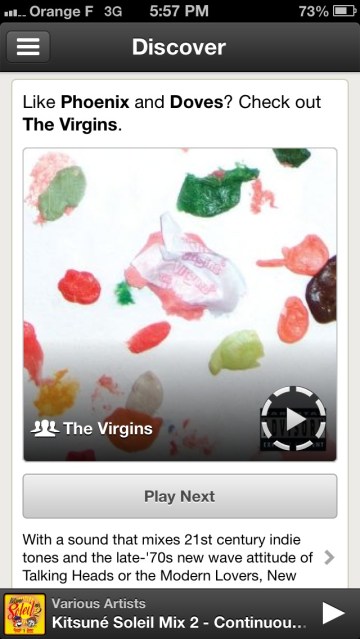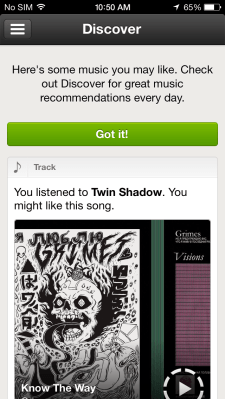Spotify‘s “Discover” feature, a news feed offering recommendations, songs and playlists based on your current listening habits, has today made its way to the iPhone through an update to the Spotify iOS app, which also includes a number of other bug fixes and improvements, including a new “Now Playing” view and updated app icon.
The company had first announced the Discover feature back in December 2012, but didn’t begin the rollout until April. Initially, the option was made available only to a limited number of beta testers in the U.K. and Nordic countries before its public debut in May. But even then, Discover was only a publicly available option in Spotify’s web application, not its mobile clients.
 However, we learned that some users were able to beta test the Discover on iPhone feature before today’s broader debut. One TechCrunch writer with a French IP address says he’s had access to Discover in the App Store version 0.6.4.2 of Spotify’s app. (Today’s update is version 0.7.1). This user is also missing the new “Now Playing” view which arrived in the update, indicating that he may be in some smaller beta test group. (Screenshot at right).
However, we learned that some users were able to beta test the Discover on iPhone feature before today’s broader debut. One TechCrunch writer with a French IP address says he’s had access to Discover in the App Store version 0.6.4.2 of Spotify’s app. (Today’s update is version 0.7.1). This user is also missing the new “Now Playing” view which arrived in the update, indicating that he may be in some smaller beta test group. (Screenshot at right).
For most of Spotify’s user base, though, today will be the first time they’ll have access to this new type of music discovery experience on mobile – and only on iPhone, as the feature is not yet available on the iPad version or on other mobile platforms.
The feature is powered by algorithms similar to Spotify’s radio for music discovery purposes, but it’s not limited to recommendations made solely based on your plays. Discover will also alert users to New Releases on Spotify, music that’s popular in their area or popular on Spotify more generally, music shared by artists and others you follow, and more.
The addition of Discover for iPhone is timely, given that Apple recently announced its own Spotify competitor with the debut of iTunes Radio, a streaming music service that also takes into account users’ music listening behavior in order to make recommendations and build genre-based playlists. That service, which will arrive in the iOS 7 update later this year for U.S. users, includes access to the entire iTunes catalog of over 26 million tracks. Spotify, meanwhile, claims a catalog of over 20 million tracks – a database whose actual size may vary by country.
Building the Music Graph
Before the introduction of Discover and other social features like Spotify’s “Follow” option, which allows users to find and follow music influencers like artists and journalists, Spotify’s music discovery options were more limited. Users had to rely on Spotify’s radio, or find and follow their Facebook friends to be introduced to new music. That latter option, of course, is not always ideal. Although some of your Facebook friends will share some of your musical tastes and interests, many will not.
 Spotify’s attempt at building unique “music graphs” for individual users then may become its key selling point and competitive stance versus what Apple is now introducing with iTunes Radio. These music graphs are different from Facebook’s “friend graph,” as they’re more tailored to each user’s preferences. They also offer more diverse recommendations than Apple’s Genius, because it looks beyond your own play history and music collection to find new music. In addition, Discover will help to increase users’ time in app, which is good for Spotify’s ad-supported business, too.
Spotify’s attempt at building unique “music graphs” for individual users then may become its key selling point and competitive stance versus what Apple is now introducing with iTunes Radio. These music graphs are different from Facebook’s “friend graph,” as they’re more tailored to each user’s preferences. They also offer more diverse recommendations than Apple’s Genius, because it looks beyond your own play history and music collection to find new music. In addition, Discover will help to increase users’ time in app, which is good for Spotify’s ad-supported business, too.
When the feature was first announced, Spotify founder Daniel Ek explained that the answer to the challenge of sifting through the world’s music was to make discovery more personal, the way it used to be when friends lent records to each other or told each other about new songs in person. But that model needed to move beyond just “social” friends to really work.
Spotify today says that the “Discover” feature is now “coming soon to everyone,” but did not also announce a timeframe for its arrival to other mobile platforms or the iPad, which was not included in the new iOS update.
